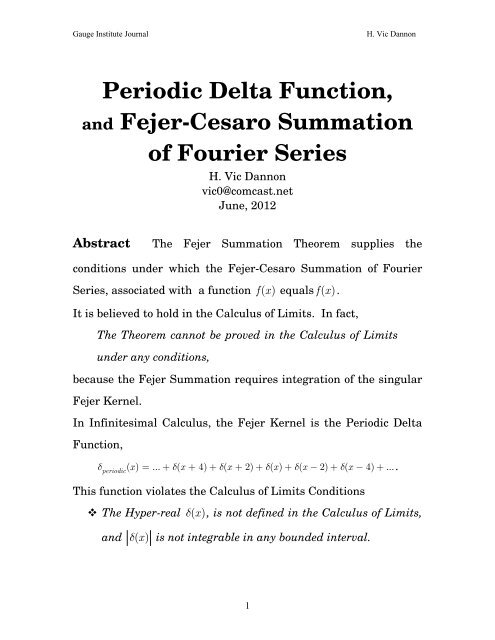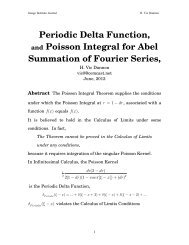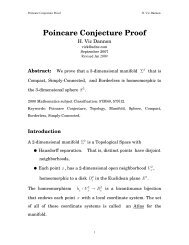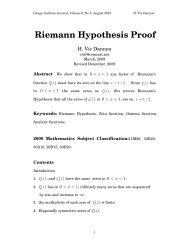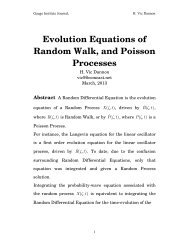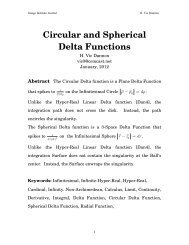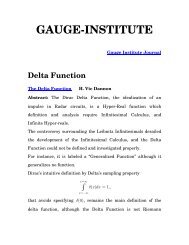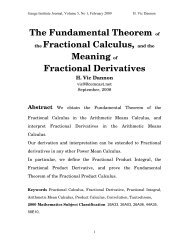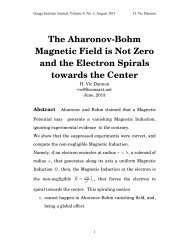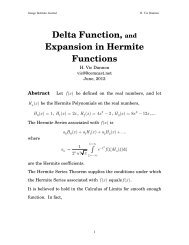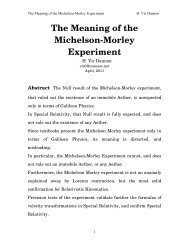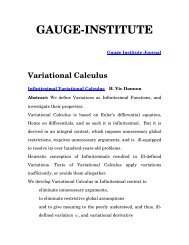Periodic Delta Function and Fejer-Cesaro - Gauge-institute.org
Periodic Delta Function and Fejer-Cesaro - Gauge-institute.org
Periodic Delta Function and Fejer-Cesaro - Gauge-institute.org
Create successful ePaper yourself
Turn your PDF publications into a flip-book with our unique Google optimized e-Paper software.
<strong>Gauge</strong> Institute Journal<br />
H. Vic Dannon<br />
<strong>Periodic</strong> <strong>Delta</strong> <strong>Function</strong>,<br />
<strong>and</strong> <strong>Fejer</strong>-<strong>Cesaro</strong> Summation<br />
of Fourier Series<br />
H. Vic Dannon<br />
vic0@comcast.net<br />
June, 2012<br />
Abstract<br />
The <strong>Fejer</strong> Summation Theorem supplies the<br />
conditions under which the <strong>Fejer</strong>-<strong>Cesaro</strong> Summation of Fourier<br />
Series, associated with a function f ( x ) equals f ( x ).<br />
It is believed to hold in the Calculus of Limits. In fact,<br />
The Theorem cannot be proved in the Calculus of Limits<br />
under any conditions,<br />
because the <strong>Fejer</strong> Summation requires integration of the singular<br />
<strong>Fejer</strong> Kernel.<br />
In Infinitesimal Calculus, the <strong>Fejer</strong> Kernel is the <strong>Periodic</strong> <strong>Delta</strong><br />
<strong>Function</strong>,<br />
δ periodic( x ) = ... + δ ( x + 4) + δ ( x + 2) + δ ( x ) + δ ( x − 2) + δ ( x − 4) + ... .<br />
This function violates the Calculus of Limits Conditions<br />
The Hyper-real<br />
δ( x)<br />
, is not defined in the Calculus of Limits,<br />
<strong>and</strong><br />
δ ( x)<br />
is not integrable in any bounded interval.<br />
1
<strong>Gauge</strong> Institute Journal<br />
H. Vic Dannon<br />
<br />
1<br />
(<br />
2<br />
δ( x + 0) + δ( x − 0) ) = 0 does not replace δ( x)<br />
at its<br />
discontinuity point, x = 0 .<br />
But δ <strong>Periodic</strong>( x ) equals its <strong>Fejer</strong> Summation, <strong>and</strong> the <strong>Fejer</strong><br />
Summation associated with any periodic hyper-real f ( x ), equals<br />
f ( x ).<br />
Keywords: Infinitesimal, Infinite-Hyper-Real, Hyper-Real,<br />
infinite Hyper-real, Infinitesimal Calculus, <strong>Delta</strong> <strong>Function</strong>,<br />
<strong>Periodic</strong> <strong>Delta</strong> <strong>Function</strong>, <strong>Delta</strong> Comb, Fourier Series, Dirichlet<br />
Kernel, <strong>Fejer</strong> Kernel, <strong>Fejer</strong>-<strong>Cesaro</strong> Summation, <strong>Fejer</strong> Summation<br />
Theorem,<br />
2000 Mathematics Subject Classification 26E35; 26E30;<br />
26E15; 26E20; 26A06; 26A12; 03E10; 03E55; 03E17; 03H15;<br />
46S20; 97I40; 97I30<br />
2
<strong>Gauge</strong> Institute Journal<br />
H. Vic Dannon<br />
Contents<br />
0. The Origin of the <strong>Fejer</strong> Summation Theorem<br />
1. The Divergence of the <strong>Fejer</strong> Kernel in the Calculus of Limits<br />
2. Hyper-real line.<br />
3. Integral of a Hyper-real <strong>Function</strong><br />
4. <strong>Delta</strong> <strong>Function</strong><br />
5. <strong>Periodic</strong> <strong>Delta</strong> <strong>Function</strong>, δ ( ξ − x)<br />
6. Convergent Series<br />
periodic<br />
7. <strong>Fejer</strong> Sequence <strong>and</strong> δ ( ξ − x)<br />
periodic<br />
8. <strong>Fejer</strong> Kernel <strong>and</strong> δ ( ξ − x)<br />
periodic<br />
9. <strong>Fejer</strong> Summation <strong>and</strong> δ ( ξ − x)<br />
periodic<br />
10. <strong>Fejer</strong> Summation Theorem<br />
References<br />
3
<strong>Gauge</strong> Institute Journal<br />
H. Vic Dannon<br />
The Origin of the <strong>Fejer</strong>-<strong>Cesaro</strong><br />
Summation Theorem<br />
Let f ( x ) be a function defined on [ − 1 ,1], so that f (1) = f ( − 1) .<br />
The Fourier Coefficients of f ( x ) are<br />
1<br />
2<br />
ξ=<br />
1<br />
−inπξ<br />
∫ f () ξ e dξ<br />
≡ c n<br />
, n = ..., −2, −1, 0,1,2,... ,<br />
ξ=−1<br />
The Fourier Series partial sums<br />
ξ = 1<br />
{ } { 1 −inπξ ( −x) 1 −i πξ ( −x) 1 1 iπξ ( −x) 1 inπξ<br />
( −x)<br />
( ) = ∫ ( ξ) + ... + + + + ... +<br />
2 2 2 2 2<br />
}<br />
S n<br />
fx f e e e e dξ<br />
,<br />
<br />
ξ =−1<br />
give rise to the Dirichlet Sequence<br />
0.1 <strong>Cesaro</strong><br />
Dirichlet Sequence<br />
1 −inπx 1 −i πx 1 1 iπx inπ<br />
x<br />
2 2 2 2<br />
Dn<br />
( x) = e + ... + e + + e + ... + 1 e<br />
2<br />
= + cos πx<br />
+ cos 2 πx<br />
+ ... + cosnπ<br />
x<br />
1<br />
2<br />
sin( n + ) πx<br />
= , n = 0,1, 2,..<br />
2sin x<br />
1<br />
2<br />
1<br />
π<br />
2<br />
To assign a numerical value to the divergent series<br />
1− 1+ 1− 1+ 1− 1 + ...,<br />
<strong>Cesaro</strong> suggested to consider the convergence of the Arithmetic<br />
Means of its Partial Sums<br />
4
<strong>Gauge</strong> Institute Journal<br />
H. Vic Dannon<br />
σ<br />
σ<br />
σ<br />
σ<br />
0<br />
= s0 = 1,<br />
s + s 1 + (1−1)<br />
= = = ,<br />
2 2<br />
0 1 1<br />
1 2<br />
s + s + s 1 + (1− 1) + (1− 1+<br />
1)<br />
= = = ,<br />
3 3<br />
0 1 2 2<br />
2 3<br />
s + s + s + s 1 + (1− 1) + (1− 1+ 1) + (1− 1+ 1−1)<br />
= = = ,<br />
4 4<br />
0 1 2 3 1<br />
3 2<br />
……………………………………………………………………………..<br />
Thus,<br />
σ +<br />
= ,<br />
1<br />
2k<br />
1 2<br />
<strong>and</strong> the series converges to 1 2 .<br />
we conclude that<br />
σ<br />
k+<br />
1 1<br />
2k<br />
= →<br />
2k<br />
+ 1 2<br />
the infinite series 1− 1 + 1− 1+ 1− 1 + ... has <strong>Cesaro</strong> Sum of<br />
1<br />
2<br />
For any series<br />
a0 + a1 + a2 + a3 + ..., with partial sums s 0<br />
, s 1<br />
, s 2<br />
,...<br />
s0 + s1 + ... + s<br />
If m<br />
m + 1<br />
→<br />
σ<br />
0.2 <strong>Fejer</strong><br />
Then σ is the <strong>Cesaro</strong> Sum of a0 + a1 + a2 + a3 + ...<br />
applied <strong>Cesaro</strong> summation to Fourier Series.<br />
The <strong>Fejer</strong> Summation partial sums are the Arithmetic Means<br />
5
<strong>Gauge</strong> Institute Journal<br />
H. Vic Dannon<br />
FS<br />
ej<br />
n<br />
{ fx ( )}<br />
=<br />
{ f ( x ) } + { f ( x ) } + ... + { f ( x ) }<br />
S S S<br />
0 1<br />
n + 1<br />
n<br />
ξ=<br />
1<br />
1<br />
= ( ) {( 1)<br />
1<br />
∫ f ξ n + + ncos[ π( ξ − x)] + ... + cos[ πn( ξ −x)]}<br />
dξ.<br />
n + 1<br />
2<br />
<br />
ξ=−1<br />
<strong>Fejer</strong> Sequence<br />
The <strong>Fejer</strong> Summation associated with the function f ( x ) is clearly<br />
different from the Fourier Series associated with f ( x ), but it may<br />
nevertheless converge to f ( x ).<br />
The equality of the <strong>Fejer</strong> Summation associated with f ( x ), to f ( x )<br />
is the <strong>Fejer</strong> Summation Theorem.<br />
The question is under which conditions does the Theorem hold.<br />
6
<strong>Gauge</strong> Institute Journal<br />
H. Vic Dannon<br />
1.<br />
The Divergence of the <strong>Fejer</strong><br />
Kernel in the Calculus of Limits<br />
The <strong>Fejer</strong> Summation is believed to converge to f ( x ) provided that<br />
1. f ( x ) is integrable on [ −1<br />
,1]<br />
2. f ( x ) is periodic with period T = 2<br />
1<br />
3. (<br />
2<br />
fx ( + 0) + fx ( − 0) ) replaces f ( x ) at a discontinuity point.<br />
These Conditions reflect the belief that the equality depends only<br />
on the function, regardless of the singularity of the <strong>Fejer</strong> Kernel.<br />
The <strong>Fejer</strong> Summation is not an infinite series, where<br />
S n+ 1<br />
= S n<br />
+ a n+ 1. It has a singular Kernel, <strong>and</strong> it raises the<br />
question whether it equals<br />
f ( x ).<br />
In the Calculus of Limits, no smoothness of the function<br />
guarantees the convergence of the <strong>Fejer</strong> Summation.<br />
1.1 The <strong>Fejer</strong> Kernel is either singular or zero<br />
In the Calculus of Limits, the <strong>Fejer</strong> Summation is the limit of the<br />
1 −<br />
n−1 −<br />
n−1<br />
{ }<br />
in x i x i x in x<br />
ej n<br />
fx ( ) = π π π<br />
c<br />
ne ... c<br />
1e c0 ce<br />
1<br />
... ce<br />
n −<br />
+ + n −<br />
+ + + + π<br />
n<br />
n n<br />
FS<br />
1<br />
7
<strong>Gauge</strong> Institute Journal<br />
H. Vic Dannon<br />
⎛ ⎞ ⎛ ⎞ ⎛<br />
= + + + +<br />
⎜ ⎜ ⎝ ⎠ ⎝ ⎠ ⎝⎜<br />
ξ= 1 ξ= 1 ξ=<br />
1<br />
1 ∫ −inπξ inπx () ...<br />
1<br />
() ...<br />
1<br />
inπξ inπx<br />
f ξe dξ e f ξdξ −<br />
f()<br />
ξe dξ<br />
e<br />
2n<br />
∫ 2 ∫ 2n<br />
ξ=− 1<br />
⎟<br />
ξ=− 1<br />
⎟<br />
ξ=−1<br />
ξ = 1<br />
∫<br />
ξ =−1<br />
{ 1 −inπξ ( −x) n−<br />
1 −iπξ ( −x) 1 n−<br />
1 iπξ ( −x) 1 inπξ<br />
( −x)<br />
}<br />
= f() ξ e + ... + e + + e + ... + e dξ<br />
<br />
2n 2n 2 2<br />
n 2n<br />
<strong>Fejer</strong> Sequence<br />
⎞⎟⎠<br />
.<br />
As n<br />
→∞, the <strong>Fejer</strong> Sequence becomes the <strong>Fejer</strong> Kernel, which is<br />
singular, <strong>and</strong> diverges at any ξ − x = 2k.<br />
Thus, the <strong>Fejer</strong> Summation does not converge in the Calculus of<br />
Limits.<br />
Avoiding the singularity at<br />
ξ = x , by using the Cauchy Principal<br />
Value of the integral does not recover the Theorem, because at any<br />
ξ −x<br />
≠ 2k, the <strong>Fejer</strong> Kernel vanishes, <strong>and</strong> the integral is<br />
identically zero, for any function<br />
f ( x ).<br />
Plots of the <strong>Fejer</strong> sequence confirm that<br />
In the Calculus of Limits,<br />
the <strong>Fejer</strong> Kernel is either singular or zero<br />
1.2 Plots of <strong>Fejer</strong> Sequence<br />
plots the spikes at x = 0 , x =−2,<br />
x = 2<br />
8
<strong>Gauge</strong> Institute Journal<br />
H. Vic Dannon<br />
gives 9 spikes<br />
9
<strong>Gauge</strong> Institute Journal<br />
H. Vic Dannon<br />
Thus, the <strong>Fejer</strong> Summation Theorem does not hold in the Calculus<br />
of Limits.<br />
1.3 Infinitesimal Calculus Solution<br />
By resolving the problem of the infinitesimals [Dan2], we obtained<br />
the Infinite Hyper-reals that are strictly smaller than ∞ , <strong>and</strong><br />
constitute the value of the <strong>Delta</strong> <strong>Function</strong> at the singularity.<br />
The controversy surrounding the Leibnitz Infinitesimals derailed<br />
the development of the Infinitesimal Calculus, <strong>and</strong> the <strong>Delta</strong><br />
<strong>Function</strong> could not be defined <strong>and</strong> investigated properly.<br />
In Infinitesimal Calculus, [Dan3], we can differentiate over jump<br />
discontinuities, <strong>and</strong> integrate over singularities.<br />
The <strong>Delta</strong> <strong>Function</strong>, the idealization of an impulse in Radar<br />
circuits, is a Discontinuous Hyper-Real function which definition<br />
requires Infinite Hyper-reals, <strong>and</strong> which analysis requires<br />
Infinitesimal Calculus.<br />
In [Dan5], we show that in infinitesimal Calculus, the hyper-real<br />
ω=∞<br />
1<br />
( x)<br />
e i ω<br />
δ = x ω<br />
2π<br />
∫ d<br />
ω=−∞<br />
is zero for any x ≠ 0 ,<br />
10
<strong>Gauge</strong> Institute Journal<br />
H. Vic Dannon<br />
it spikes at<br />
x = 0 , so that its Infinitesimal Calculus<br />
x =∞<br />
∫<br />
integral is δ( xdx ) = 1,<br />
<strong>and</strong><br />
x =−∞<br />
1<br />
δ (0) = < ∞.<br />
dx<br />
Here, we show that in Infinitesimal calculus, the <strong>Fejer</strong> Kernel is<br />
the periodic hyper-real <strong>Delta</strong> <strong>Function</strong>: A periodic train of <strong>Delta</strong><br />
<strong>Function</strong>s.<br />
And the <strong>Fejer</strong> Summation FS { f ( x)<br />
associated with a Hyperreal<br />
periodic function f ( x ), equals f ( x ).<br />
ej<br />
}<br />
11
<strong>Gauge</strong> Institute Journal<br />
H. Vic Dannon<br />
2.<br />
Hyper-real Line<br />
Each real number α can be represented by a Cauchy sequence of<br />
rational numbers, ( r , r , r ,...) so that r → α .<br />
1 2 3<br />
The constant sequence ( ααα , , ,...) is a constant hyper-real.<br />
In [Dan2] we established that,<br />
1. Any totally ordered set of positive, monotonically decreasing<br />
n<br />
to zero sequences<br />
infinitesimal hyper-reals.<br />
( ι1, ι2, ι3,...)<br />
constitutes a family of<br />
2. The infinitesimals are smaller than any real number, yet<br />
strictly greater than zero.<br />
1 1 1<br />
3. Their reciprocals ( , , ,...<br />
ι 1<br />
ι 2<br />
ι 3<br />
) are the infinite hyper-reals.<br />
4. The infinite hyper-reals are greater than any real number,<br />
yet strictly smaller than infinity.<br />
5. The infinite hyper-reals with negative signs are smaller<br />
than any real number, yet strictly greater than −∞.<br />
6. The sum of a real number with an infinitesimal is a<br />
non-constant hyper-real.<br />
7. The Hyper-reals are the totality of constant hyper-reals, a<br />
family of infinitesimals, a family of infinitesimals with<br />
12
<strong>Gauge</strong> Institute Journal<br />
H. Vic Dannon<br />
negative sign, a family of infinite hyper-reals, a family of<br />
infinite hyper-reals with negative sign, <strong>and</strong> non-constant<br />
hyper-reals.<br />
8. The hyper-reals are totally ordered, <strong>and</strong> aligned along a<br />
line: the Hyper-real Line.<br />
9. That line includes the real numbers separated by the nonconstant<br />
hyper-reals. Each real number is the center of an<br />
interval of hyper-reals, that includes no other real number.<br />
10. In particular, zero is separated from any positive real<br />
by the infinitesimals, <strong>and</strong> from any negative real by the<br />
infinitesimals with negative signs, −dx .<br />
11. Zero is not an infinitesimal, because zero is not strictly<br />
greater than zero.<br />
12. We do not add infinity to the hyper-real line.<br />
13. The infinitesimals, the infinitesimals with negative<br />
signs, the infinite hyper-reals, <strong>and</strong> the infinite hyper-reals<br />
with negative signs are semi-groups with<br />
respect to addition. Neither set includes zero.<br />
14. The hyper-real line is embedded in , <strong>and</strong> is not<br />
∞<br />
homeomorphic to the real line. There is no bi-continuous<br />
one-one mapping from the hyper-real onto the real line.<br />
13
<strong>Gauge</strong> Institute Journal<br />
H. Vic Dannon<br />
15. In particular, there are no points on the real line that<br />
can be assigned uniquely to the infinitesimal hyper-reals, or<br />
to the infinite hyper-reals, or to the non-constant hyperreals.<br />
16. No neighbourhood of a hyper-real is homeomorphic to<br />
an<br />
n<br />
ball. Therefore, the hyper-real line is not a manifold.<br />
17. The hyper-real line is totally ordered like a line, but it<br />
is not spanned by one element, <strong>and</strong> it is not one-dimensional.<br />
14
<strong>Gauge</strong> Institute Journal<br />
H. Vic Dannon<br />
3.<br />
Integral of a Hyper-real <strong>Function</strong><br />
In [Dan3], we defined the integral of a Hyper-real <strong>Function</strong>.<br />
Let f () x be a hyper-real function on the interval [ ab] , .<br />
The interval may not be bounded.<br />
f () x may take infinite hyper-real values, <strong>and</strong> need not be<br />
bounded.<br />
At each<br />
a<br />
≤<br />
x<br />
≤b,<br />
there is a rectangle with base<br />
dx dx<br />
[ x − , x + 2<br />
], height f () x , <strong>and</strong> area<br />
2<br />
f ( xdx. )<br />
We form the Integration Sum of all the areas for the x ’s that<br />
start at x = a, <strong>and</strong> end at x = b,<br />
∑ f ( xdx ) .<br />
x∈[ a, b]<br />
If for any infinitesimal dx , the Integration Sum has the same<br />
hyper-real value, then f () x is integrable over the interval [ ab] , .<br />
Then, we call the Integration Sum the integral of f () x from x = a,<br />
to x<br />
= b, <strong>and</strong> denote it by<br />
15
<strong>Gauge</strong> Institute Journal<br />
H. Vic Dannon<br />
x=<br />
b<br />
∫ f ( xdx ) .<br />
x=<br />
a<br />
If the hyper-real is infinite, then it is the integral over [, ab] ,<br />
If the hyper-real is finite,<br />
x=<br />
b<br />
∫ fxdx ( ) = real part of the hyper-real . <br />
x=<br />
a<br />
3.1 The countability of the Integration Sum<br />
In [Dan1], we established the equality of all positive infinities:<br />
We proved that the number of the Natural Numbers,<br />
Card , equals the number of Real Numbers,<br />
2 Card <br />
Card = , <strong>and</strong><br />
we have<br />
2 Card<br />
2<br />
Card <br />
Card = ( Card) = .... = 2 = 2 = ... ≡ ∞.<br />
In particular, we demonstrated that the real numbers may be<br />
well-ordered.<br />
Consequently, there are countably many real numbers in the<br />
interval [ ab] , , <strong>and</strong> the Integration Sum has countably many terms.<br />
While we do not sequence the real numbers in the interval, the<br />
summation takes place over countably many f ( xdx. )<br />
The Lower Integral is the Integration Sum where f ( x ) is replaced<br />
16
<strong>Gauge</strong> Institute Journal<br />
H. Vic Dannon<br />
by its lowest value on each interval<br />
3.2<br />
∑<br />
x∈[ a, b]<br />
⎛<br />
⎜⎝<br />
dx dx<br />
2 2<br />
[ x − , x + ]<br />
⎞<br />
inf f ( t)<br />
dx<br />
⎠⎟<br />
x− ≤t≤ x+<br />
dx dx<br />
2 2<br />
The Upper Integral is the Integration Sum where f ( x ) is replaced<br />
by its largest value on each interval<br />
3.3<br />
∑<br />
x∈[ a, b]<br />
⎛<br />
⎜⎝<br />
dx dx<br />
2 2<br />
[ x − , x + ]<br />
⎞ sup f ( t)<br />
dx<br />
⎠⎟<br />
x− ≤t≤ x+<br />
dx dx<br />
2 2<br />
If the integral is a finite hyper-real, we have<br />
3.4 A hyper-real function has a finite integral if <strong>and</strong> only if its<br />
upper integral <strong>and</strong> its lower integral are finite, <strong>and</strong> differ by an<br />
infinitesimal.<br />
17
<strong>Gauge</strong> Institute Journal<br />
H. Vic Dannon<br />
4.<br />
<strong>Delta</strong> <strong>Function</strong><br />
In [Dan5], we have defined the <strong>Delta</strong> <strong>Function</strong>, <strong>and</strong> established its<br />
properties<br />
1. The <strong>Delta</strong> <strong>Function</strong> is a hyper-real function defined from the<br />
hyper-real line into the set of two hyper-reals<br />
⎧<br />
⎪ 1 ⎫<br />
⎨0, ⎪<br />
⎬<br />
⎪⎩<br />
dx ⎪ . The<br />
⎭<br />
hyper-real<br />
0 is the sequence 0, 0, 0,... . The infinite hyperreal<br />
1<br />
dx<br />
depends on our choice of dx .<br />
2. We will usually choose the family of infinitesimals that is<br />
spanned by the sequences<br />
1<br />
n , 1<br />
2<br />
n<br />
,<br />
1<br />
n<br />
3<br />
,… It is a<br />
semigroup with respect to vector addition, <strong>and</strong> includes all<br />
the scalar multiples of the generating sequences that are<br />
non-zero. That is, the family includes infinitesimals with<br />
negative sign. Therefore,<br />
1<br />
dx<br />
will mean the sequence n .<br />
Alternatively, we may choose the family spanned by the<br />
sequences<br />
1<br />
2 n ,<br />
1<br />
3 n ,<br />
1<br />
4 n ,… Then, 1<br />
dx<br />
will mean the<br />
18
<strong>Gauge</strong> Institute Journal<br />
H. Vic Dannon<br />
sequence 2 n<br />
. Once we determined the basic infinitesimal<br />
dx , we will use it in the Infinite Riemann Sum that defines<br />
an Integral in Infinitesimal Calculus.<br />
3. The <strong>Delta</strong> <strong>Function</strong> is strictly smaller than ∞<br />
4. We define,<br />
1<br />
χ δ ( x) ≡ dx ( )<br />
,<br />
dx x<br />
dx<br />
⎡ ⎤ ,<br />
⎢−<br />
⎣ 2 2 ⎥⎦<br />
where<br />
χ ⎡<br />
⎢−<br />
⎣<br />
dx,<br />
dx<br />
2 2<br />
⎧ dx dx<br />
1, x ∈ ⎡−<br />
, ⎤<br />
( x)<br />
= ⎪ ⎢ 2 2 ⎥<br />
⎨ ⎣ ⎦ .<br />
⎪⎪ 0, otherwise<br />
⎩<br />
⎤<br />
⎥⎦<br />
5. Hence,<br />
for x < 0 , δ ( x) = 0<br />
at<br />
for<br />
dx<br />
x =− , δ( x)<br />
jumps from 0 to<br />
2<br />
dx dx<br />
⎢ ⎣<br />
,<br />
2 2 ⎥ ⎦ , 1<br />
( x)<br />
x ∈ ⎡−<br />
⎤<br />
δ = .<br />
dx<br />
1<br />
dx ,<br />
at x = 0 ,<br />
δ (0) =<br />
1<br />
dx<br />
at<br />
dx<br />
x = , δ( x)<br />
drops from<br />
2<br />
for x > 0 , δ ( x) = 0.<br />
xδ ( x) = 0<br />
1<br />
dx to 0.<br />
6. If dx =<br />
1<br />
, ( x) = 1 1( x),2 1 1( x),3 1 1( x )...<br />
n<br />
[ − , ] [ − , ] [ − , ]<br />
δ χ χ χ<br />
2 2 4 4 6 6<br />
7. If dx =<br />
2<br />
,<br />
n<br />
1 2 3<br />
δ ( x) = , , ,...<br />
2 2 2<br />
2 cosh x 2 cosh 2x 2 cosh 3x<br />
19
<strong>Gauge</strong> Institute Journal<br />
H. Vic Dannon<br />
8. If dx =<br />
1<br />
,<br />
n<br />
− x − 2x − 3x<br />
[0, ∞) [0, ∞) [0, ∞)<br />
δ( x) = e χ ,2 e χ , 3 e χ ,...<br />
x =∞<br />
∫<br />
9. δ( xdx ) = 1.<br />
x =−∞<br />
In [Dan6], we obtained<br />
10.<br />
k =∞<br />
1 −ik( ξ−x<br />
)<br />
δξ ( − x)<br />
= e<br />
2π<br />
∫ dk<br />
k =−∞<br />
In [Dan8], we defined the <strong>Periodic</strong> <strong>Delta</strong> <strong>Function</strong>, <strong>and</strong> obtained<br />
11.<br />
δ <strong>Periodic</strong>( x ) = ... + δ ( x + 4) + δ ( x + 2) + δ ( x ) + δ ( x − 2) + δ ( x − 4) + ...<br />
1 −inπx 1 −i πx 1 1 iπx 1 inπx<br />
e e e e<br />
2 2 2 2 2<br />
= ... + + ... + + + + ... + + ...<br />
20
<strong>Gauge</strong> Institute Journal<br />
H. Vic Dannon<br />
5.<br />
<strong>Periodic</strong> <strong>Delta</strong> <strong>Function</strong> δ ( ξ − x)<br />
5.1 <strong>Periodic</strong> <strong>Delta</strong> <strong>Function</strong><br />
periodic<br />
δ<strong>Periodic</strong>( ξ− x) = ... + δξ ( − x + 2) + δξ ( − x) + δξ ( −x<br />
− 2) +...<br />
is a periodic hyper-real <strong>Delta</strong> function, with period T = 2 .<br />
In [Dan8], we obtained<br />
1 inπξ ( x ) 1 iπξ ( x) 1 1 iπξ ( x) 1 inπξ<br />
( x )<br />
2 2 2 2 2<br />
− − − − − −<br />
δ<strong>Periodic</strong>( ξ − x) = .. + e + .. + e + + e + .. + e + ..<br />
21
<strong>Gauge</strong> Institute Journal<br />
H. Vic Dannon<br />
6.<br />
Convergent Series<br />
In [Dan10], we defined convergence of infinite series in<br />
Infinitesimal Calculus<br />
6.1 Sequence Convergence to a finite hyper-real a<br />
a → a iff a − a = infinitesimal .<br />
n<br />
n<br />
6.2 Sequence Convergence to an infinite hyper-real A<br />
a → A iff a<br />
n<br />
represents the infinite hyper-real A.<br />
n<br />
6.3 Series Convergence to a finite hyper-real s<br />
a1 + a2 + ... → s iff a1 + ... + an<br />
− s = infinitesimal .<br />
6.4 Series Convergence to an Infinite Hyper-real S<br />
a1 + a2 + ... → S<br />
iff<br />
a<br />
1<br />
+ ... +a<br />
n<br />
represents the infinite hyper-real S .<br />
22
<strong>Gauge</strong> Institute Journal<br />
H. Vic Dannon<br />
7.<br />
<strong>Fejer</strong> Sequence <strong>and</strong> δ ( ξ − x)<br />
periodic<br />
7.1 <strong>Fejer</strong> Sequence Definition<br />
Let f ( x ) be an integrable function on [ −1 ,1].<br />
Then, for each<br />
n = ..., −3, −2, −1, 0,1,2, 3,... , the integrals<br />
1<br />
2<br />
ξ=<br />
1<br />
∫<br />
ξ=−1<br />
−inπξ<br />
f () ξ e dξ<br />
≡ c n<br />
are the Fourier Coefficients of f ( x ).<br />
The Fourier Series partial sums<br />
ξ = 1<br />
{ } { 1 −inπξ ( −x) 1 −iπξ ( −x) 1 1 iπξ ( −x) 1 inπξ<br />
( −x)<br />
( ) = ∫ ( ξ) + ... + + + + ... +<br />
2 2 2 2 2<br />
}<br />
S n<br />
fx f e e e e dξ<br />
,<br />
<br />
ξ =−1<br />
give rise to the Dirichlet Sequence<br />
Dirichlet Sequence<br />
1 −inπx 1 −i πx 1 1 iπx inπ<br />
x<br />
2 2 2 2<br />
Dn<br />
( x) = e + ... + e + + e + ... + 1 e<br />
2<br />
= + cos πx<br />
+ cos 2 πx<br />
+ ... + cosnπ<br />
x<br />
1<br />
2<br />
sin( n + ) πx<br />
= , n = 0,1, 2,..<br />
2sin x<br />
1<br />
2<br />
1<br />
π<br />
2<br />
The <strong>Fejer</strong> Summation partial sums are the Arithmetic Means<br />
FS<br />
ej<br />
n<br />
{ fx ( )}<br />
=<br />
{ f ( x) } + { f( x) } + ... + { f( x)<br />
}<br />
S S S<br />
0 1<br />
n + 1<br />
n<br />
23
<strong>Gauge</strong> Institute Journal<br />
H. Vic Dannon<br />
ξ=<br />
1<br />
1<br />
= ( ) {( 1)<br />
1<br />
∫ f ξ n + + ncos[ π( ξ − x)] + ... + cos[ πn( ξ −x)]}<br />
dξ.<br />
n + 1<br />
2<br />
<br />
ξ=−1<br />
They give rise to the <strong>Fejer</strong> Sequence<br />
<strong>Fejer</strong> Sequence<br />
F ( x ) = + cos[ πξ ( − x )] + ... + cos[ π n ( ξ−<br />
x )]<br />
1 n<br />
1<br />
n 2 n+ 1 n+<br />
1<br />
7.2<br />
1 m−1<br />
m−( m−1)<br />
m 1<br />
π<br />
2 m m<br />
F<br />
−<br />
( x) = + cos x + ... + cos( m − 1) πx<br />
,<br />
D ( x ) + D ( x ) + ... D ( x )<br />
m<br />
0 1 m−1<br />
= ,<br />
2 1<br />
2<br />
2 1<br />
2<br />
1 sin ( mπx)<br />
= , m = 1, 2, ..<br />
2m<br />
sin ( πx)<br />
Proof:<br />
F<br />
m−1<br />
D0( x) + D1( x) + ... Dm<br />
−1( x)<br />
( x) =<br />
m<br />
1 3 1<br />
1<br />
⎧<br />
sin πx sin πx sin( m ) ⎫<br />
⎪<br />
− πx<br />
2 2 2<br />
= ...<br />
⎪<br />
⎨ + + +<br />
⎬<br />
m 2sin1πx 2sin1πx<br />
2sin1<br />
⎪<br />
π<br />
⎩<br />
x<br />
2 2 2 ⎪⎭<br />
1<br />
= + + + x<br />
2 2 2<br />
2msin<br />
πx<br />
1<br />
2<br />
{ sin 1 πx sin 3 πx ... sin( m −<br />
1 ) π }<br />
cos 0−cos πx cos πx−cos2πx<br />
cos( m−1) πx−cosmπx<br />
{ ...<br />
1πx 1πx 1πx<br />
}<br />
1<br />
= + + +<br />
2msin<br />
πx<br />
1 2sin 2sin 2sin<br />
2<br />
1<br />
= −<br />
4msin<br />
πx<br />
2 1<br />
2<br />
2 2 2<br />
{ 1 cosmπx}<br />
24
<strong>Gauge</strong> Institute Journal<br />
H. Vic Dannon<br />
2 1<br />
2<br />
2 1<br />
2<br />
1 sin ( mπx)<br />
= .<br />
2m<br />
sin ( πx)<br />
7.3 <strong>Fejer</strong> Sequence is a <strong>Periodic</strong> <strong>Delta</strong> Sequence, <strong>and</strong><br />
represents a <strong>Periodic</strong> <strong>Delta</strong> <strong>Function</strong><br />
Each<br />
F<br />
m<br />
2 1<br />
1 2<br />
1( x)<br />
m 2 1<br />
2<br />
sin ( mπx)<br />
−<br />
= , m = 1, 2, 3,...<br />
2 sin ( πx)<br />
1. has the sifting property on each interval,<br />
x =−3<br />
∫<br />
... F ( x) dx = 1; F ( x) dx = 1; F ( x) dx = 1…<br />
x =−5<br />
m−1<br />
2. is a continuous function<br />
x =−1<br />
∫<br />
x =−3<br />
m−1<br />
x = 1<br />
∫<br />
x =−1<br />
m−1<br />
1<br />
3. peaks on each of these intervals to lim F ( x)<br />
= m.<br />
Proof of (1)<br />
x= 1 x=<br />
1<br />
⎡1 m−1 1<br />
m−1 ⎢⎣<br />
π<br />
2 m m<br />
x=− 1 x=−1<br />
x→2k<br />
∫ ∫ x<br />
F ( x) dx = + cos x + ... + cos( m −1)<br />
πx⎤<br />
⎥⎦<br />
d<br />
= 1.<br />
Proof of (3)<br />
1<br />
1 x x<br />
m 1 1<br />
sin x ... sin( m 1) x<br />
=<br />
−<br />
π<br />
π<br />
⎤<br />
2 mπ<br />
m( m− 1) π<br />
⎥⎦x<br />
=−1<br />
=<br />
⎡<br />
⎢ + + + −<br />
⎣<br />
m<br />
2<br />
As x → 0 ,<br />
2 1<br />
2<br />
2 1<br />
2<br />
1 sin ( mπx)<br />
0<br />
→<br />
2m<br />
sin ( πx)<br />
0<br />
25
<strong>Gauge</strong> Institute Journal<br />
H. Vic Dannon<br />
Applying Bernoulli’s rule,<br />
⎡sin ⎤<br />
1 ⎢ '<br />
⎣ ⎦ 1 (2 sin )cos ( )<br />
→<br />
2m ⎡<br />
⎢sin<br />
2 m (2 sin x)cos x( )<br />
⎣ ⎦<br />
2 1<br />
mπx 1 1 1<br />
2 ⎥<br />
mπx mπx mπ<br />
2 2 2<br />
2 1 0<br />
1 1<br />
πx<br />
⎤' x→<br />
π π<br />
1π<br />
2 ⎥<br />
2 2 2 x = 0<br />
1sinmπx<br />
0<br />
= =<br />
2 sin 0<br />
π x<br />
x = 0<br />
Applying Bernoulli’s rule to 1sin mπx<br />
2 sinπx<br />
,<br />
1[sin mπx]' 1πmcosmπx<br />
1<br />
→ = m .<br />
πx<br />
π πx<br />
2<br />
2 [sin ]' x→0<br />
2 cos<br />
x = 0<br />
7.4 <strong>Fejer</strong> Sequence Represents a <strong>Periodic</strong> <strong>Delta</strong> <strong>Function</strong><br />
δ<br />
periodic<br />
1<br />
⎛sin πξ ( x)<br />
⎞<br />
−<br />
( ξ − x)<br />
= 2m<br />
⎜ sin πξ ( x)<br />
⎜⎝ − ⎠⎟<br />
m<br />
2<br />
1<br />
2<br />
2<br />
26
<strong>Gauge</strong> Institute Journal<br />
H. Vic Dannon<br />
8.<br />
<strong>Fejer</strong> Kernel <strong>and</strong> δ ( ξ − x)<br />
periodic<br />
8.1 <strong>Fejer</strong> Kernel in the Calculus of Limits<br />
2 1<br />
2<br />
2 1<br />
2<br />
1 sin ( )<br />
ejer ( ) lim mπξ−<br />
x<br />
F ξ − x =<br />
m→∞<br />
2 m sin πξ ( − x)<br />
1 m−1<br />
m−( m−1)<br />
{ πξ x<br />
m πξ }<br />
= lim + cos ( − ) + ... + cos( −1) ( −x )<br />
m→∞<br />
2<br />
m<br />
m<br />
8.2 In the Calculus of Limits, the <strong>Fejer</strong> Kernel does not have<br />
Proof:<br />
the sifting property<br />
By 4.3, as ξ −x<br />
→ 2k,<br />
2 1<br />
1 sin mπξ<br />
( − x)<br />
2m<br />
2<br />
sin<br />
1<br />
πξ ( − x)<br />
Hence,<br />
2 →<br />
1<br />
2<br />
2<br />
m .<br />
2 1<br />
1 sin mπξ<br />
( x)<br />
2 1<br />
lim lim lim<br />
m→∞ ξ−x→2k 2m<br />
2 1<br />
2<br />
sin πξ ( − x)<br />
m→∞<br />
2<br />
−<br />
→ m =<br />
∞.<br />
8.3 Hyper-real <strong>Fejer</strong> Kernel in Infinitesimal Calculus<br />
F<br />
ejer<br />
⎧⎪<br />
1<br />
n , ξ x 2<br />
( ξ x)<br />
⎪ − = k<br />
− = 2<br />
⎨ .<br />
⎪ 0, ξ − x ≠ 2k<br />
⎪⎩<br />
27
<strong>Gauge</strong> Institute Journal<br />
H. Vic Dannon<br />
Proof: at any ξ − x = 2k,<br />
2 1<br />
mπξ−<br />
x<br />
2<br />
=<br />
1<br />
2 1<br />
2<br />
πξ−<br />
x<br />
2 ξ− x=<br />
2k<br />
1 sin ( )<br />
2m<br />
sin ( )<br />
m<br />
. <br />
For ξ −x<br />
≠ 2k, <strong>and</strong> for any m ,<br />
Mx ( ). Therefore,<br />
2 1<br />
2<br />
2 1<br />
2<br />
sin mπξ<br />
( − x)<br />
sin πξ ( − x)<br />
is bounded by<br />
2 1<br />
mπξ−<br />
x<br />
2<br />
≤<br />
1<br />
2 1<br />
2m<br />
πξ−<br />
x<br />
2<br />
1 sin ( )<br />
0 ≤<br />
M(<br />
ξ<br />
2m<br />
sin ( )<br />
− x)<br />
Hence, for ξ −x<br />
≠ 2k,<br />
2 1<br />
2<br />
2 1<br />
2<br />
1 sin mπξ<br />
( − x)<br />
=<br />
2m<br />
sin πξ ( − x)<br />
infinitesimal .<br />
8.4 Let 1 N = 1 be an infinite Hyper-real. Then,<br />
2 dx<br />
F<br />
ejer<br />
( ξ − x)<br />
=<br />
2 1<br />
2<br />
2 1<br />
2<br />
1 sin Nπξ<br />
( − x)<br />
2N<br />
sin πξ ( − x)<br />
1 N −1<br />
2 N<br />
N−( N−1)<br />
N<br />
= + cos πξ ( − x) + ... + cos( N −1) πξ ( −x )<br />
= ... + δξ ( − x + 2) + δξ ( − x) + δξ ( −x<br />
− 2) + ...<br />
= δ ( ξ −x)<br />
periodic<br />
Proof:<br />
1 N −1<br />
N−( N−1)<br />
ejer<br />
ξ<br />
π ξ<br />
2 N N<br />
F ( − x) = + cos ( − x) + ... + cos( N −1) π( ξ −x)<br />
28
<strong>Gauge</strong> Institute Journal<br />
H. Vic Dannon<br />
By 8.3,<br />
⎧⎪ , ξ − x = − 2 ⎧⎪ , ξ = x ⎧⎪<br />
, ξ − x = 2<br />
= + ⎨ + ⎨ + ⎨<br />
+<br />
⎪ 0, ξ −x ≠ −2 ⎪ 0, ξ ≠ x ⎪ 0, ξ −x<br />
≠ 2<br />
⎩ ⎩ ⎩<br />
N N N<br />
... ⎪ 2 ⎪ 2 ⎪ 2<br />
...<br />
⎧ 1<br />
, ξ − x = − 2 ⎧ 1<br />
, ξ = x ⎧<br />
1<br />
, ξ − x = 2<br />
= ... +<br />
dx dx dx<br />
⎨<br />
⎪ + ⎨<br />
⎪ + ⎨<br />
⎪<br />
+ ...<br />
⎪ 0, ξ −x ≠ −2 ⎪ 0, ξ ≠ x ⎪ 0, ξ −x<br />
≠ 2<br />
⎩ ⎩ ⎩<br />
= ... + δξ ( − x + 2) + δξ ( − x) + δξ ( −x<br />
− 2) + ...<br />
= δ ( ξ −x). <br />
<strong>Periodic</strong><br />
29
<strong>Gauge</strong> Institute Journal<br />
H. Vic Dannon<br />
9.<br />
<strong>Fejer</strong> Summation <strong>and</strong> δ ( ξ − x)<br />
periodic<br />
9.1 <strong>Fejer</strong> Summation of a Hyper-real <strong>Function</strong><br />
Let f ( x ) be a hyper-real function integrable on [ −1 ,1].<br />
Then, for each<br />
n = ..., −3, −2, −1, 0,1,2, 3,... , the integrals<br />
1<br />
2<br />
ξ=<br />
1<br />
∫<br />
ξ=−1<br />
−inπξ<br />
f () ξ e dξ<br />
≡ c n<br />
exist, with finite, or infinite hyper-real values. The<br />
c n<br />
are the<br />
Fourier Coefficients of<br />
f ( x ).<br />
The Fourier Series partial sums<br />
ξ = 1<br />
{ } { 1 −inπξ ( −x) 1 −i πξ ( −x) 1 1 iπξ ( −x) 1 inπξ<br />
( −x)<br />
( ) = ∫ ( ξ) + ... + + + + ... +<br />
2 2 2 2 2<br />
}<br />
S n<br />
fx f e e e e dξ<br />
,<br />
<br />
ξ =−1<br />
give rise to the Dirichlet Sequence<br />
Dirichlet Sequence<br />
1 −inπx 1 −i πx 1 1 iπx inπ<br />
x<br />
2 2 2 2<br />
Dn<br />
( x) = e + ... + e + + e + ... + 1 e<br />
2<br />
= + cos πx<br />
+ cos 2 πx<br />
+ ... + cosnπ<br />
x<br />
1<br />
2<br />
sin( n + ) πx<br />
= , n = 0,1, 2,..<br />
2sin x<br />
1<br />
2<br />
1<br />
π<br />
2<br />
The <strong>Fejer</strong> Summation partial sums are the Arithmetic Means<br />
30
<strong>Gauge</strong> Institute Journal<br />
H. Vic Dannon<br />
FS<br />
ej<br />
n<br />
{ fx ( )}<br />
=<br />
{ f ( x ) } + { f ( x ) } + ... + { f ( x ) }<br />
S S S<br />
0 1<br />
n + 1<br />
n<br />
ξ=<br />
1<br />
1<br />
= ( ) {( 1)<br />
1<br />
∫ f ξ n + + ncos[ π( ξ − x)] + ... + cos[ πn( ξ −x)]}<br />
dξ.<br />
n + 1<br />
2<br />
<br />
ξ=−1<br />
They give rise to the <strong>Fejer</strong> Sequence<br />
<strong>Fejer</strong> Sequence<br />
F ( x ) = + cos[ πξ ( − x )] + ... + cos[ π n ( ξ−<br />
x )]<br />
1 n<br />
1<br />
n 2 n+ 1 n+<br />
1<br />
By 4.2, for m = 1, 2, ..,<br />
F ( x) cos πx ... cos( m 1) π<br />
1 m−1 1<br />
m 1 2 m m<br />
−<br />
= + + + − x,<br />
D ( x ) + D ( x ) + ... D ( x )<br />
m<br />
0 1 m−1<br />
= ,<br />
2 1<br />
2<br />
2 1<br />
2<br />
1 sin ( mπx)<br />
= .<br />
2m<br />
sin ( πx)<br />
Let 1 N = 1 be an infinite Hyper-real.<br />
2 dx<br />
The Hyper-real <strong>Fejer</strong> Kernel is<br />
F ( x) = + cos πx + ... + cos( N −1)<br />
πx<br />
1 N −1 1<br />
ejer 2 N N<br />
= ... + δ( x + 4) + δ( x + 2) + δ( x) + δ( x − 2) + δ( x + 4)...<br />
The <strong>Fejer</strong> Summation associated with f ( x ) is<br />
1 −<br />
N−1 −<br />
N−1<br />
{ }<br />
Ni x i x i x Ni x<br />
ejer<br />
fx ( ) = π π π<br />
c<br />
Ne ... c<br />
1e c0 ce<br />
1<br />
... ce<br />
N −<br />
+ + N −<br />
+ + + + π<br />
N<br />
N N<br />
F S<br />
1<br />
For each x , it may assume finite or infinite hyper-real values.<br />
31
<strong>Gauge</strong> Institute Journal<br />
H. Vic Dannon<br />
9.2 F S{ x }<br />
δ ( ξ − ) = δ ( ξ −x)<br />
ejer <strong>Periodic</strong> <strong>Periodic</strong><br />
Proof: Let N be an infinite hyper-real.<br />
( ) (<br />
{ ( x )} 1 c e πξ<br />
− = + .. +<br />
N − 1c<br />
e<br />
ejer <strong>Periodic</strong> N −N<br />
Ni x iπξ<br />
x<br />
N −1<br />
− − − − )<br />
F S δ ξ<br />
N −1 iπξ<br />
( −x) 1 Niπξ<br />
( −x)<br />
0 1<br />
..<br />
N<br />
N N<br />
+ c + ce + + c e ,<br />
where<br />
u=<br />
1<br />
N−n 1<br />
π<br />
• c n<br />
= ∫ δ <strong>Periodic</strong><br />
( u)<br />
e du,<br />
N<br />
2<br />
u=−1<br />
−in u<br />
• T = 2 is the period,<br />
• <strong>and</strong> c = 0.<br />
For δ ( ) with T = 2 ,<br />
<strong>Periodic</strong> u<br />
N−n N n<br />
u=<br />
1<br />
1<br />
2<br />
u=−1<br />
−inπu<br />
c = ⎡... + δ( u + 2) + δ( u) + δ( u − 2) + ... ⎤<br />
∫ ⎣<br />
⎦<br />
e du<br />
Therefore,<br />
u=<br />
1<br />
1 −inπu<br />
1<br />
δ( ue ) du<br />
2 2<br />
u=−1<br />
= ∫ = .<br />
( ) ( )<br />
{ } 1 −iN πξ−x ( ) ...<br />
1 −iπξ−x<br />
δ ξ − = + +<br />
<strong>Fejer</strong>S<br />
<strong>Periodic</strong><br />
x e e<br />
by 5.<br />
2 2<br />
= δ ( ξ −x),<br />
<strong>Periodic</strong><br />
1 1 i πξ ( − x ) 1 ( )<br />
...<br />
iN πξ−<br />
e<br />
e<br />
x<br />
2 2 2<br />
+ + + + ,<br />
32
<strong>Gauge</strong> Institute Journal<br />
H. Vic Dannon<br />
10.<br />
<strong>Fejer</strong> Summation Theorem<br />
The <strong>Fejer</strong> Summation Theorem for a hyper-real function, f ( x ), is<br />
the Fundamental Theorem of <strong>Fejer</strong> Summation.<br />
It supplies the conditions under which the <strong>Fejer</strong> Summation<br />
associated with f ( x ) equals f ( x ).<br />
It is believed to hold in the Calculus of Limits under some<br />
Conditions. In fact,<br />
The Theorem cannot be proved in the Calculus of Limits<br />
under any conditions,<br />
because the <strong>Fejer</strong> Summation requires integration of the singular<br />
<strong>Fejer</strong> Kernel.<br />
10.1 <strong>Fejer</strong> Summation Theorem cannot be proved in<br />
the Calculus of Limits<br />
Proof: Take L = 1, <strong>and</strong> c = 0.<br />
In the Calculus of Limits, the <strong>Fejer</strong> Summation is the limit of<br />
FS<br />
1 −<br />
1<br />
{ ( )} in π<br />
= x + ... +<br />
n−<br />
fx c e c e<br />
ej n n −n<br />
n<br />
−1<br />
−i πx<br />
n−1 iπx<br />
1<br />
n<br />
n<br />
inπx<br />
+ c 0<br />
+ ce 1<br />
+ ... + c e ,<br />
n<br />
33
<strong>Gauge</strong> Institute Journal<br />
H. Vic Dannon<br />
⎛ ⎞ ⎛<br />
= + +<br />
⎜⎝ ⎠ ⎝<br />
ξ= 1 ξ=<br />
1<br />
1 inπξ inπx ( ) ...<br />
n 1<br />
iπξ iπx<br />
f ξe dξ −<br />
e −<br />
f( ξ)<br />
e dξ<br />
−<br />
e<br />
2n<br />
∫<br />
2n<br />
∫<br />
ξ=− 1 ⎟<br />
⎜<br />
ξ=−1<br />
⎟<br />
⎛ ⎞ ⎛ ⎞ ⎛<br />
+ + + +<br />
⎜ ⎜ ⎝ ⎠ ⎝ ⎠ ⎝⎜<br />
ξ=<br />
1<br />
∫<br />
ξ=−1<br />
ξ= 1 ξ= 1 ξ=<br />
1<br />
1 ∫ f () d n 1 f i i x<br />
() e πξ d e π<br />
...<br />
1<br />
f in in<br />
() e πξ d e π<br />
ξ ξ −<br />
−<br />
ξ ξ −<br />
ξ ξ<br />
2 ∫ 2n<br />
∫<br />
x<br />
2n<br />
ξ=− 1 ⎟ ξ=− 1 ⎟<br />
ξ=−1<br />
{<br />
1 inπξ<br />
( −x ) n−1<br />
iπξ<br />
( −x<br />
)<br />
2n<br />
2n<br />
= f ( ξ) e + ... + e<br />
As n<br />
→∞, the <strong>Fejer</strong> Sequence<br />
1 inπξ<br />
( −x ) n−1<br />
iπξ<br />
( −x<br />
n( ξ ) ...<br />
2n 2n<br />
)<br />
F − x = e + + e<br />
⎞<br />
⎠<br />
1<br />
+ +<br />
2<br />
n−1 −iπξ<br />
( −x) 1 −inπξ<br />
( −x)<br />
e ... e<br />
2n<br />
2n<br />
+ + + d ξ .<br />
1 n−1 −iπξ<br />
( −x) 1 −inπξ<br />
( −x)<br />
e ... e<br />
2 2n<br />
2n<br />
+ + + +<br />
becomes the <strong>Fejer</strong> Kernel, the infinite series<br />
1 inπξ<br />
( −x ) n−1<br />
iπξ<br />
( −x<br />
)<br />
e<br />
e<br />
2n<br />
2n<br />
... + + ... +<br />
1 1 −iπξ<br />
( −x) n 1 in ( x)<br />
e<br />
− − πξ−<br />
e<br />
2 2n<br />
2n<br />
+ + + ... + + ...,<br />
By 8.2, The <strong>Fejer</strong> Kernel is singular whenever ξ − x = 2k, <strong>and</strong><br />
the <strong>Fejer</strong> Summation diverges in the Calculus of Limits.<br />
⎞⎟⎠<br />
}<br />
Avoiding the singularity at<br />
ξ − x =<br />
2k, by using the Cauchy<br />
Principal Value of the integral does not recover the Theorem,<br />
because at any<br />
ξ −x<br />
≠<br />
2k, the <strong>Fejer</strong> Kernel is zero, <strong>and</strong> the<br />
integral is identically zero, for any function<br />
f ( x ).<br />
34
<strong>Gauge</strong> Institute Journal<br />
H. Vic Dannon<br />
Thus, the <strong>Fejer</strong> Summation Theorem cannot be proved the<br />
Calculus of Limits.<br />
10.2 Calculus of Limits Conditions are irrelevant to <strong>Fejer</strong><br />
Summation Theorem<br />
Proof: The <strong>Fejer</strong> Conditions are<br />
1. f ( x ) is integrable on [ c − L,<br />
c + L]<br />
2. f ( x ) is periodic with period T = 2L<br />
1<br />
3. (<br />
2<br />
fx ( + 0) + fx ( − 0) ) replaces f ( x ) at a discontinuity point.<br />
It is clear from 10.1 that the <strong>Fejer</strong> conditions on f ( x ) do not<br />
resolve the singularity of the <strong>Fejer</strong> kernel, <strong>and</strong> are not sufficient<br />
for the <strong>Fejer</strong> Summation Theorem. <br />
In Infinitesimal Calculus, by 8.4, the <strong>Fejer</strong> Kernel is the <strong>Periodic</strong><br />
<strong>Delta</strong> <strong>Function</strong>, <strong>and</strong> by 9.2, it equals its <strong>Fejer</strong> Summation.<br />
Then, the <strong>Fejer</strong> Summation Theorem holds for any periodic<br />
integrable Hyper-Real <strong>Function</strong>:<br />
10.3 <strong>Fejer</strong> Summation Theorem for Hyper-real f ( x )<br />
If f ( x ) is hyper-real function integrable on [ c − L, c + L]<br />
, so that<br />
f ( c − L) = f(<br />
c + L)<br />
35
<strong>Gauge</strong> Institute Journal<br />
H. Vic Dannon<br />
Then, f ( x) = F S{ f( x )}<br />
ejer<br />
Proof: Take L = 1, c = 0, <strong>and</strong><br />
1N = 1 an infinite Hyper- real.<br />
ξ=<br />
1<br />
∫<br />
ξ=−1<br />
2 dx<br />
{ }<br />
f ( x) = f( ξ) ... + δ( ξ − x + 2) + δ( ξ − x) + δ( ξ −x<br />
− 2) + ...<br />
dξ<br />
δ<br />
<strong>Periodic</strong><br />
By 8.4, δ ( ξ − x) = F ( ξ −x)<br />
ξ = 1<br />
∫<br />
ξ=−1<br />
<strong>Periodic</strong><br />
{<br />
1 iN πξ ( −x) N −1<br />
iπξ<br />
( −x)<br />
2N<br />
2N<br />
= f ( ξ) e + ... + e<br />
ej<br />
( ξ−x<br />
), where the period of <strong>Delta</strong> is T=2<br />
+<br />
1<br />
+<br />
2<br />
N − 1 −iπξ<br />
( −x) 1 −iNπξ<br />
( −x<br />
e ... e )<br />
2N<br />
2N<br />
}<br />
+ + + d ξ .<br />
In [Dan6], we established that the Fourier Transform,<br />
ξ=∞<br />
−i<br />
2πνξ<br />
∫ f () ξ e dξ,<br />
ξ=−∞<br />
exists for any Hyper-real function<br />
fx ( ). That is, the summation<br />
ξ=∞<br />
∑<br />
ξ=−∞<br />
−i<br />
2πνξ<br />
f () ξ e dξ<br />
exists for any Hyper-real function<br />
fx ( )<br />
. Consequently, the<br />
summations over intervals exist, <strong>and</strong> we may write the integral as<br />
the sum of integrals over intervals<br />
⎛ ξ= 1 ⎞ ⎛ ξ=<br />
1 ⎞ ⎛ ξ= 1<br />
⎞ 1 1 iN πξ iN πx () ...<br />
N 1 1 iπξ iπx<br />
f ξe dξ −<br />
e<br />
−<br />
−<br />
f() ξe dξ = e<br />
1<br />
+ + +<br />
f()<br />
ξdξ<br />
N<br />
2 ∫<br />
2N<br />
2 ∫<br />
⎟+<br />
2<br />
⎜⎝ ξ=− 1 ⎠⎟<br />
⎝⎜<br />
ξ=− 1 ⎠⎟<br />
∫<br />
⎝⎜<br />
ξ=−1<br />
⎟<br />
⎠<br />
c<br />
−N<br />
c<br />
−1 0<br />
c<br />
36
<strong>Gauge</strong> Institute Journal<br />
H. Vic Dannon<br />
⎛ ⎞ ⎛<br />
⎞<br />
+ + +<br />
⎝ ⎠ ⎝<br />
⎠<br />
<br />
<br />
ξ= 1 ξ=<br />
1<br />
N −1 1 −iπξ iπx () ...<br />
1 1<br />
iNπξ iNπ<br />
f ξe dξ e −<br />
f()<br />
ξe dξ<br />
x<br />
e<br />
2N<br />
2 ∫<br />
2N<br />
2 ∫<br />
⎜<br />
ξ=− 1<br />
⎟<br />
⎜<br />
ξ=−1<br />
⎟<br />
c<br />
1<br />
1 c iN x N 1 i x N 1 i x iN x<br />
N<br />
e − π −<br />
... c 1 e − π c −<br />
0 ce π<br />
1<br />
... c N −<br />
N −<br />
N<br />
N<br />
e π<br />
= + + + + + + 1<br />
N<br />
ej<br />
{ f ( x)<br />
}<br />
= FS .<br />
c<br />
N<br />
In particular, the <strong>Periodic</strong> <strong>Delta</strong> <strong>Function</strong> violates the <strong>Fejer</strong><br />
Conditions<br />
The Hyper-real<br />
δ( x)<br />
, is not defined in the Calculus of Limits,<br />
<strong>and</strong><br />
δ ( x)<br />
is not integrable in any bounded interval.<br />
<br />
1<br />
(<br />
2<br />
δ( x + 0) + δ( x − 0) ) = 0 does not replace δ( x)<br />
at its<br />
discontinuity point, x = 0 .<br />
But by 9.2,<br />
<strong>Periodic</strong>( x )<br />
satisfies the <strong>Fejer</strong> Summation Theorem.<br />
δ<br />
37
<strong>Gauge</strong> Institute Journal<br />
H. Vic Dannon<br />
References<br />
[Achieser] Achieser, N. I., Theory of Approximation, Ungar, 1956.<br />
[Carslaw] Carslaw, H. S., “Introduction to the Theory of Fourier Series <strong>and</strong><br />
integrals” Third Edition, Macmillan, 1930.<br />
[Dan1] Dannon, H. Vic, “Well-Ordering of the Reals, Equality of all Infinities,<br />
<strong>and</strong> the Continuum Hypothesis” in <strong>Gauge</strong> Institute Journal Vol. 6 No. 2, May<br />
2010;<br />
[Dan2] Dannon, H. Vic, “Infinitesimals” in <strong>Gauge</strong> Institute Journal Vol.6 No.<br />
4, November 2010;<br />
[Dan3] Dannon, H. Vic, “Infinitesimal Calculus” in <strong>Gauge</strong> Institute Journal<br />
Vol. 7 No. 4, November 2011;<br />
[Dan4] Dannon, H. Vic, “Riemann’s Zeta <strong>Function</strong>: the Riemann Hypothesis<br />
Origin, the Factorization Error, <strong>and</strong> the Count of the Primes”, in <strong>Gauge</strong><br />
Institute Journal of Math <strong>and</strong> Physics, Vol. 5, No. 4, November 2009.<br />
[Dan5] Dannon, H. Vic, “The <strong>Delta</strong> <strong>Function</strong>” in <strong>Gauge</strong> Institute Journal Vol.<br />
8, No. 1, February, 2012;<br />
[Dan6] Dannon, H. Vic, “<strong>Delta</strong> <strong>Function</strong>, the Fourier Transform, <strong>and</strong> the<br />
Fourier Integral Theorem” in <strong>Gauge</strong> Institute Journal Vol. 8, No. 2, May,<br />
2012;<br />
[Dan7] Dannon, H. Vic, “Riemannian Trigonometric Series”, <strong>Gauge</strong> Institute<br />
Journal, Volume 7, No. 3, August 2011.<br />
[Dan8] Dannon, H. Vic, “<strong>Periodic</strong> <strong>Delta</strong> <strong>Function</strong> <strong>and</strong> Dirichlet Summation of<br />
Fourier Series” posted to www.gauge-institue.<strong>org</strong>;<br />
[Dan9] Dannon, H. Vic, “Lebesgue Integration” <strong>Gauge</strong> Institute Journal Vol.7<br />
No. 1, February 2011;<br />
38
<strong>Gauge</strong> Institute Journal<br />
H. Vic Dannon<br />
[Dan10] Dannon, H. Vic, “Infinite Series with Infinite Hyper-real Sum ” in<br />
<strong>Gauge</strong> Institute Journal Vol. 8, No. 3, August, 2012;<br />
[Davis] Davis, Philip, “Interpolation <strong>and</strong> Approximation” Blaisdell, 1963.<br />
[Hardy] Hardy, G. H., Divergent Series, Chelsea 1991.<br />
[Kreider] Kreider, Kuller, Ostberg, Perkins, “an introduction to real analysis”<br />
Addison Wesley, 1966<br />
[Natanson] Natanson, I. P., “Constructive <strong>Function</strong> Theory” Ungar, 1964.<br />
[Rogosinski] Rogosinski, Werner, “Fourier Series” Chelsea, 1950.<br />
[Tolstov] Tolstov, Ge<strong>org</strong>i, “Fourier Series” Prentice-Hall,1962<br />
[Zygmund] Zygmund, A., “Trigonometric Series”, Second Edition, Cambridge<br />
University Press, 1968.<br />
39


